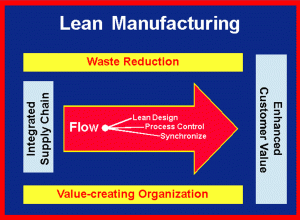 Lean manufacturing was developed in the mid to late 1940’s, after the end of World War II. Initially conceived by automaker Toyota, the concept caught on with other industries so that by the 1970’s it was being used worldwide by various manufacturing facilities. The idea of lean manufacturing is just as it sounds, to produce products in a fast, efficient manner at the lowest prices while catering to customer specifications. The concept of lean manufacturing is based on five basic principles, all of which work together to help businesses.
Lean manufacturing was developed in the mid to late 1940’s, after the end of World War II. Initially conceived by automaker Toyota, the concept caught on with other industries so that by the 1970’s it was being used worldwide by various manufacturing facilities. The idea of lean manufacturing is just as it sounds, to produce products in a fast, efficient manner at the lowest prices while catering to customer specifications. The concept of lean manufacturing is based on five basic principles, all of which work together to help businesses.
The first of these principles is specifying value. Having a complete understanding of what a customer wants before producing an item is considered the most efficient way to create a product. Waste is avoided by building a product to specifications, and communicating with the customer is key to making this happen. By doing so, a product is produced with specifically what the customer wants, leading to happy customers and an efficient production process.
Identifying steps is next in the lean manufacturing process. The goal in this step is to manufacture the product in the quickest time with as little waste as possible. Mapping out the necessary steps to do so is key, because it eliminates unnecessary steps and ultimately waste.
The next step is known as process flow. Once the path to make the product has been laid out, it’s time for the process flow. With this, the idea is each step in the process should move into the next one without any hesitation. The whole process should be perfectly timed and seamless, just like a well-oiled machine. From start to finish, everything should run smoothly. By eliminating unnecessary steps, the margin of error is virtually eliminated or severely reduced.
Pulling inventory is the next principle of lean manufacturing, and possibly its most important. Lean manufacturing built its reputation on using as little inventory as possible in order to keep costs low, so very careful attention is paid to just what is being used and how much of it is being used. Only what is absolutely needed is pulled from inventory and put on the manufacturing floor to be used. Referred to as Just-in-Time manufacturing, the concept is a company makes only what is needed when it is needed.
Continual Improvement is the final concept of lean manufacturing. Like anything else, a process improves with practice and can be constantly evaluated for weak links in the manufacturing chain. The idea in this concept is to eliminate as much or all waste associated with the process. Waste in this case is defined as unneeded steps or too much idle time in the manufacturing process. By using continual improvement, products can be manufactured quicker and cheaper, leading to lower prices for consumers and more successful manufacturers.
By utilizing lean manufacturing, businesses can expect to see substantial improvements in how items are produced and the costs associated with them. By always striving to be the best, businesses can continue to adapt and embrace change.
This post comes from MCP Europe, the experts at lean manufacturing in the UK. If you think your business could benefit from lean manufacturing principles, give their website a look.

